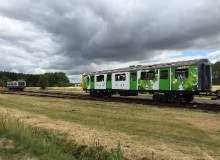
In the context of rising passenger demand in the UK and ambitious government plans to build a Northern Powerhouse with rail traffic at its core, the cost for new, improved rolling stock is an increasingly heavy burden for both the taxpayer and the rail industry.
To counteract this and other challenges public transportation faces today, UK company Vivarail has brought forward a completely innovative idea: to source and refurbish old, high-quality rolling stock and transform it into modern passenger trains, all at a fraction of the cost of buying conventional new rolling stock.
Vivarail, a company founded in 2012 by ex-Chiltern Railways chairman Adrian Shooter CBE, draws on the background knowledge of a small team with almost 200 years of combined experience in railway engineering and operations.
The company’s project, the D-Train, is an ambitious hybrid of old and new, aimed at equipping the discarded shells of old carriages with cutting-edge technology. It is aimed at serving commuter services, branch lines and tourist routes particularly in the North of England.
But with Vivarail’s even bigger ambition of entering the market in the near future, what is the technology behind the D-Train and what are the credentials that brought it the moniker of “The Green Machine”?
Breathing new life into old stock
Looking back at Vivarail’s origins, Shooter says: “A few years ago [former TfL engineer] Malcolm Dobell and I were idly chatting about the D-stock. He told me about the sound condition of the bodyshells and the fact that the bogies were brand new. I filed the information away and then when I retired from Chiltern Railways, it came back to me.”
“I knew there was a national shortage of DMUs [diesel multiple units] and so I had another talk with Malcolm and other colleagues I had worked with in the past. After these conversations, I was convinced the D-Train project was a goer and Vivarail was born,” Shooter says.
How well do you really know your competitors?
Access the most comprehensive Company Profiles on the market, powered by GlobalData. Save hours of research. Gain competitive edge.

Thank you!
Your download email will arrive shortly
Not ready to buy yet? Download a free sample
We are confident about the unique quality of our Company Profiles. However, we want you to make the most beneficial decision for your business, so we offer a free sample that you can download by submitting the below form
By GlobalDataThe fruit of the team’s labour recently paid off: the company’s first D-Train prototype passed a scrutinising test in August, after only seven months in the making, receiving rave reviews from senior industry bodies and experts.
“We received the first trains in January and by the end of the year, we will have undertaken the approvals and mainline testing, so it’s fair to say that every month so far has been a milestone,” Shooter says. “However I think the fact we had our prototype running by early summer is a major achievement and testament to the hard work and skill of my engineering team.”
A straightforward idea with multiple benefits
The trains use the bodyshells, bogies and motors from surplus old D78 metro stock from the London Underground, which are then converted from electrical to diesel stock and fitted with a new traction system, new control electronics and new diesel generators.
On the outside, the corrosion-free aluminium bodyshells are re-engineered to offer additional collision protection, a feature that proved its worth during a recent successful crash test. On the inside, the existing electric motors are powered by new underfloor-mounted low-emission diesel engines, which benefit from with the latest automotive ‘stop-start’ technology.
“The external look is more subjective,” Shooter says. “Many people like the traditional snub nose of the D-stock but we have also designed paint and fibreglass aesthetics that will give it a different feel. It’s perhaps something that operators on different routes will have different ideas about.”
The rest of the D-Train’s components are brand-new additions, such as new engines and generators, traction control systems, gangway and lighting and a bespoke, refurbished interior that caters to specific client requirements.
As Shooter explains, “we reuse the bodyshells and the bogies of course, but essentially everything else is new.”
“Because we are using brand-new technology never tried before in the rail industry, we have had some obstacles. The integration of the new engines and gensets has not been without pitfalls and we’ve had a few sleepless nights trying to get all the software to perform as needed.”
Nevertheless, the prototype has been a success so far, especially when taking into consideration its long-term ambitions: taking inspiration from Toyota’s hybrid technology, the D-Train aims to become the first passenger train in the UK to use a stop-start motor that cuts the engine while idling, using less fuel and emitting fewer fumes as a result.
Another admirable aspect of the D-Train’s design lies in its versatility: supplied as two, three or four-car units, the configuration model is fully adaptable to fit three categories, each for different urban or rural applications. The ‘City Rail’ layout is aimed at serving busy lines with frequent stations, while the ‘Commuter Rail’ and ‘Country Rail’ concepts are designed for longer journey times where more passenger amenities are required.
“The only caveat to that is the seats,” Shooter says. “The current seats are extremely comfortable and in tests many people prefer to sit on them rather than the airline-type seats. So we offer our customers the choice to retain the originals (completely refurbished) if they wish – it also helps keep down waste and costs.”
The green machine
The D-Train’s most impressive feat is its green credentials and multiple cutbacks on costs, emissions, fuel consumption and energy use, all stemming from the initial, simple concept of minimising unnecessary waste by re-using high-standard, second-hand equipment.
“Our green credentials are second to none,” Shooter says. “Just by using the bodyshells, we have saved perfectly good trains from being scrapped and so we are saving on waste as well as starting with a neutral carbon footprint. Combined with our lower fuel consumption and the modern automotive engines, the trains are very low emission.”
Dubbed “The Green Machine”, the train is built in full compliance with the latest EU emission standards and meets the “4Cs” criteria in terms of carbon, cost, capacity and customer satisfaction. A technical overview of the project specifies that thanks to its stop-start engine, “the result is lower fuel consumption, lower emissions, and less noise – especially in stations and depots.”
Furthermore, the low weight of the carriages reduces energy use and track wear, while the upcycling process eliminates the CO2 emissions usually produced during the construction process.
Shooter points out that the concept will benefit everyone: while offering a modern environment to passengers, it also serves as a cost-effective option to train operators and easy-to-maintain stock for staff.
“The train will suit routes across the country,” she says. “Intra-city ones such as in Coventry, tourist routes in Cornwall, frequent stopping services such as Huddersfield and Sheffield and discreet lines such as Marks Tey to Sudbury.”
Currently one-of-a-kind in the UK, Shooter says the company recently found an Argentinean project “doing pretty much the same as us” so the companies are currently in talks to share experience, insight and ideas for the future.
After the success of the first prototype model, Vivarail’s next objective is to sell 75 refurbished trains over the next two to four years – not an easy feat, but given their track record so far, an entirely possible outcome.






